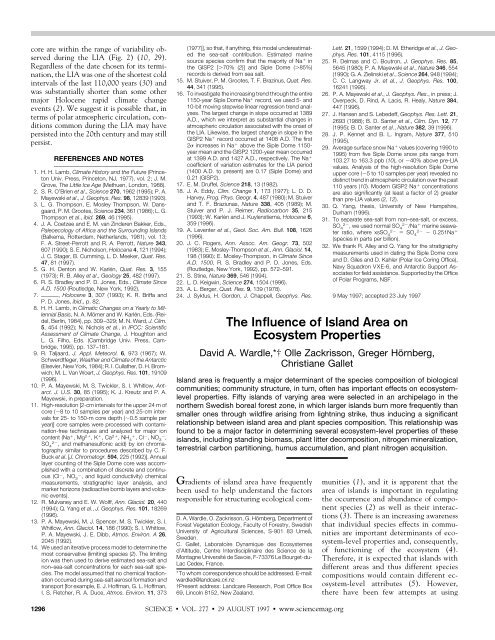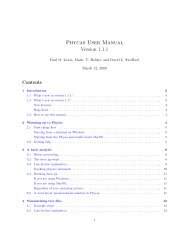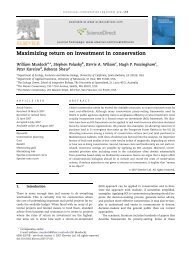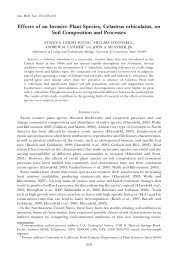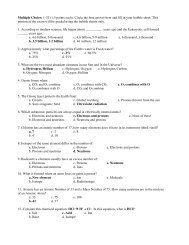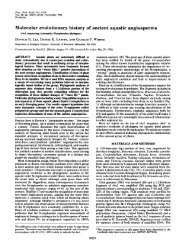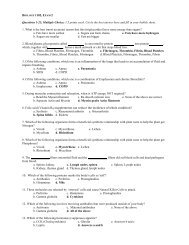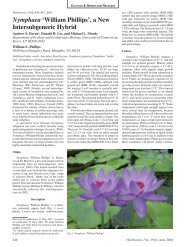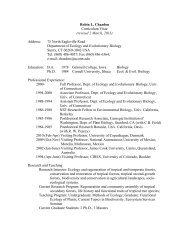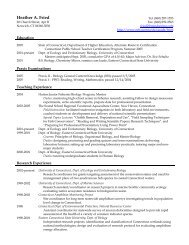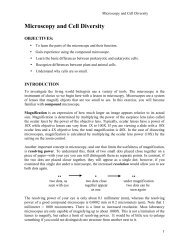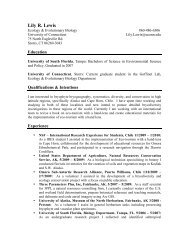The Influence of Island Area on Ecosystem Properties - Ecology and ...
The Influence of Island Area on Ecosystem Properties - Ecology and ...
The Influence of Island Area on Ecosystem Properties - Ecology and ...
Create successful ePaper yourself
Turn your PDF publications into a flip-book with our unique Google optimized e-Paper software.
core are within the range <str<strong>on</strong>g>of</str<strong>on</strong>g> variability observedduring the LIA (Fig. 2) (10, 29).Regardless <str<strong>on</strong>g>of</str<strong>on</strong>g> the date chosen for its terminati<strong>on</strong>,the LIA was <strong>on</strong>e <str<strong>on</strong>g>of</str<strong>on</strong>g> the shortest coldintervals <str<strong>on</strong>g>of</str<strong>on</strong>g> the last 110,000 years (30) <strong>and</strong>was substantially shorter than some othermajor Holocene rapid climate changeevents (2). We suggest it is possible that, interms <str<strong>on</strong>g>of</str<strong>on</strong>g> polar atmospheric circulati<strong>on</strong>, c<strong>on</strong>diti<strong>on</strong>scomm<strong>on</strong> during the LIA may havepersisted into the 20th century <strong>and</strong> may stillpersist.REFERENCES AND NOTES___________________________1. H. H. Lamb, Climate History <strong>and</strong> the Future (Princet<strong>on</strong>Univ. Press, Princet<strong>on</strong>, NJ, 1977), vol. 2; J. M.Grove, <str<strong>on</strong>g>The</str<strong>on</strong>g> Little Ice Age (Methuen, L<strong>on</strong>d<strong>on</strong>, 1988).2. S. R. O’Brien et al., Science 270, 1962 (1995); P. A.Mayewski et al., J. Geophys. Res. 98, 12839 (1993).3. L. G. Thomps<strong>on</strong>, E. Mosley Thomps<strong>on</strong>, W. Dansgaard,P. M. Grootes, Science 234, 361 (1986); L. G.Thomps<strong>on</strong> et al., ibid. 269, 46 (1995).4. J. A. Coetzee <strong>and</strong> E. M. van Zinderen Bakker, Eds.,Paleoecology <str<strong>on</strong>g>of</str<strong>on</strong>g> Africa <strong>and</strong> the Surrounding <str<strong>on</strong>g>Isl<strong>and</strong></str<strong>on</strong>g>s(Balkema, Rotterdam, Netherl<strong>and</strong>s, 1981), vol. 13;F. A. Street-Perrott <strong>and</strong> R. A. Perrott, Nature 343,607 (1990); S. E. Nichols<strong>on</strong>, Holocene 4, 121 (1994);J. C. Stager, B. Cumming, L. D. Meeker, Quat. Res.47, 81 (1997).5. G. H. Dent<strong>on</strong> <strong>and</strong> W. Karlén, Quat. Res. 3, 155(1973); R. B. Alley et al., Geology 25, 482 (1997).6. R. S. Bradley <strong>and</strong> P. D. J<strong>on</strong>es, Eds., Climate SinceA.D. 1500 (Routledge, New York, 1992).7. , Holocene 3, 307 (1993); K. R. Briffa <strong>and</strong>P. D. J<strong>on</strong>es, ibid., p. 82.8. H. H. Lamb, in Climatic Changes <strong>on</strong> a Yearly to MillennialBasis,N.A.Mörner <strong>and</strong> W. Karlén, Eds. (Reidel,Berlin, 1984), pp. 309–329; M. N. Ward, J. Clim.5, 454 (1992); N. Nichols et al., in IPCC: ScientificAssessment <str<strong>on</strong>g>of</str<strong>on</strong>g> Climate Change, J. Hought<strong>on</strong> <strong>and</strong>L. G. Filho, Eds. (Cambridge Univ. Press, Cambridge,1995), pp. 137–181.9. R. Taljaard, J. Appl. Meteorol. 6, 973 (1967); W.Schwerdtfeger, Weather <strong>and</strong> Climate <str<strong>on</strong>g>of</str<strong>on</strong>g> the Antarctic(Elsevier, New York, 1984); R. I. Cullather, D. H. Bromwich,M. L. Van Woert, J. Geophys. Res. 101, 19109(1996).10. P. A. Mayewski, M. S. Twickler, S. I. Whitlow, Antarct.J. U.S. 30, 85 (1995); K. J. Kreutz <strong>and</strong> P. A.Mayewski, in preparati<strong>on</strong>.11. High-resoluti<strong>on</strong> [2-cm intervals for the upper 24 m <str<strong>on</strong>g>of</str<strong>on</strong>g>core (8 to 10 samples per year) <strong>and</strong> 25-cm intervalsfor 25- to 150-m core depth (0.5 sample peryear)] core samples were processed with c<strong>on</strong>taminati<strong>on</strong>-freetechniques <strong>and</strong> analyzed for major i<strong>on</strong>c<strong>on</strong>tent (Na ,Mg 2 ,K ,Ca 2 ,NH 4,Cl ,NO 3,SO 42, <strong>and</strong> methanesulf<strong>on</strong>ic acid) by i<strong>on</strong> chromatographysimilar to procedures described by C. F.Buck et al.[J. Chromatogr. 594, 225 (1992)]. Annuallayer counting <str<strong>on</strong>g>of</str<strong>on</strong>g> the Siple Dome core was accomplishedwith a combinati<strong>on</strong> <str<strong>on</strong>g>of</str<strong>on</strong>g> discrete <strong>and</strong> c<strong>on</strong>tinuous(Cl ,NO 3, <strong>and</strong> liquid c<strong>on</strong>ductivity) chemicalmeasurements, stratigraphic layer analysis, <strong>and</strong>marker horiz<strong>on</strong>s (radioactive bomb layers <strong>and</strong> volcanicevents).12. R. Mulvaney <strong>and</strong> E. W. Wolff, Ann. Glaciol. 20, 440(1994); Q. Yang et al., J. Geophys. Res. 101, 18269(1996).13. P. A. Mayewski, M. J. Spencer, M. S. Twickler, S. I.Whitlow, Ann. Glaciol. 14, 186 (1990); S. I. Whitlow,P. A. Mayewski, J. E. Dibb, Atmos. Envir<strong>on</strong>. A 26,2045 (1992).14. We used an iterative process model to determine themost c<strong>on</strong>servative (limiting) species (2). <str<strong>on</strong>g>The</str<strong>on</strong>g> limitingi<strong>on</strong> was then used to derive estimated sea-salt <strong>and</strong>n<strong>on</strong>–sea-salt c<strong>on</strong>centrati<strong>on</strong>s for each sea-salt species.<str<strong>on</strong>g>The</str<strong>on</strong>g> model assumed that no chemical fracti<strong>on</strong>ati<strong>on</strong>occurred during sea-salt aerosol formati<strong>on</strong> <strong>and</strong>transport [for example, E. J. H<str<strong>on</strong>g>of</str<strong>on</strong>g>fman, G. L. H<str<strong>on</strong>g>of</str<strong>on</strong>g>fman,I. S. Fletcher, R. A. Duce, Atmos. Envir<strong>on</strong>. 11, 373(1977)], so that, if anything, this model underestimatedthe sea-salt c<strong>on</strong>tributi<strong>on</strong>. Estimated marinesource species c<strong>on</strong>firm that the majority <str<strong>on</strong>g>of</str<strong>on</strong>g> Na inthe GISP2 [70% (2)] <strong>and</strong> Siple Dome (85%)records is derived from sea salt.15. M. Stuiver, P. M. Grootes, T. F. Brazinus, Quat. Res.44, 341 (1995).16. To investigate the increasing trend through the entire1150-year Siple Dome Na record, we used 5- <strong>and</strong>10-bit moving stepwise linear regressi<strong>on</strong> trend analyses.<str<strong>on</strong>g>The</str<strong>on</strong>g> largest change in slope occurred at 1389A.D., which we interpret as substantial changes inatmospheric circulati<strong>on</strong> associated with the <strong>on</strong>set <str<strong>on</strong>g>of</str<strong>on</strong>g>the LIA. Likewise, the largest change in slope in theGISP2 Na record occurred at 1408 A.D. <str<strong>on</strong>g>The</str<strong>on</strong>g> first2 increases in Na above the Siple Dome 1150-year mean <strong>and</strong> the GISP2 1200-year mean occurredat 1399 A.D. <strong>and</strong> 1427 A.D., respectively. <str<strong>on</strong>g>The</str<strong>on</strong>g> Na coefficient <str<strong>on</strong>g>of</str<strong>on</strong>g> variati<strong>on</strong> estimates for the LIA period(1400 A.D. to present) are 0.17 (Siple Dome) <strong>and</strong>0.21 (GISP2).17. E. M. Druffel, Science 218, 13 (1982).18. J. A. Eddy, Clim. Change 1, 173 (1977); L. D. D.Harvey, Prog. Phys. Geogr. 4, 487 (1980); M. Stuiver<strong>and</strong> T. F. Braziunas, Nature 338, 405 (1989); M.Stuiver <strong>and</strong> P. J. Reimer, Radiocarb<strong>on</strong> 35, 215(1993); W. Karlén <strong>and</strong> J. Kuylenstierna, Holocene 6,359 (1996).19. A. Leventer et al., Geol. Soc. Am. Bull. 108, 1626(1996).20. J. C. Rogers, Ann. Assoc. Am. Geogr. 73, 502(1983); E. Mosley-Thomps<strong>on</strong> et al., Ann. Glaciol. 14,198 (1990); E. Mosley-Thomps<strong>on</strong>, in Climate SinceA.D. 1500, R. S. Bradley <strong>and</strong> P. D. J<strong>on</strong>es, Eds.(Routledge, New York, 1992), pp. 572–591.21. S. Stine, Nature 369, 546 (1994).22. L. D. Keigwin, Science 274, 1504 (1996).23. A. L. Berger, Quat. Res. 9, 139 (1978).24. J. Syktus, H. Gord<strong>on</strong>, J. Chappell, Geophys. Res.Lett. 21, 1599 (1994); D. M. Etheridge et al., J. Geophys.Res. 101, 4115 (1996).25. R. Delmas <strong>and</strong> C. Boutr<strong>on</strong>, J. Geophys. Res. 85,5645 (1980); P. A. Mayewski et al., Nature 346, 554(1990); G. A. Zielinski et al., Science 264, 948 (1994);C. C. Langway Jr. et al., J. Geophys. Res. 100,16241 (1995).26. P. A. Mayewski et al., J. Geophys. Res., in press; J.Overpeck, D. Rind, A. Lacis, R. Healy, Nature 384,447 (1996).27. J. Hansen <strong>and</strong> S. Lebedeff, Geophys. Res. Lett. 21,2693 (1988); B. D. Santer et al., Clim. Dyn. 12, 77(1995); B. D. Santer et al., Nature 382, 39 (1996).28. J. P. Kennet <strong>and</strong> B. L. Ingram, Nature 377, 510(1995).29. Average surface snow Na values (covering 1990 to1995) from five Siple Dome snow pits range from103.27 to 163.3 ppb (10), or 40% above pre-LIAvalues. Analysis <str<strong>on</strong>g>of</str<strong>on</strong>g> the high-resoluti<strong>on</strong> Siple Domeupper core (5 to 10 samples per year) revealed nodistinct trend in atmospheric circulati<strong>on</strong> over the past110 years (10). Modern GISP2 Na c<strong>on</strong>centrati<strong>on</strong>sare also significantly (at least a factor <str<strong>on</strong>g>of</str<strong>on</strong>g> 2) greaterthan pre-LIA values (2, 12).30. Q. Yang, thesis, University <str<strong>on</strong>g>of</str<strong>on</strong>g> New Hampshire,Durham (1996).31. To separate sea-salt from n<strong>on</strong>–sea-salt, or excess,SO 42, we used normal SO 42/Na marine seawaterratio, where xsSO 42 SO 42 0.251Na (species in parts per billi<strong>on</strong>).32. We thank R. Alley <strong>and</strong> Q. Yang for the stratigraphymeasurements used in dating the Siple Dome core<strong>and</strong> D. Giles <strong>and</strong> D. Kahler (Polar Ice Coring Office),Navy Squadr<strong>on</strong> VXE-6, <strong>and</strong> Antarctic Support Associatesfor field assistance. Supported by the Office<str<strong>on</strong>g>of</str<strong>on</strong>g> Polar Programs, NSF.9 May 1997; accepted 23 July 1997<str<strong>on</strong>g>The</str<strong>on</strong>g> <str<strong>on</strong>g>Influence</str<strong>on</strong>g> <str<strong>on</strong>g>of</str<strong>on</strong>g> <str<strong>on</strong>g>Isl<strong>and</strong></str<strong>on</strong>g> <str<strong>on</strong>g>Area</str<strong>on</strong>g> <strong>on</strong><strong>Ecosystem</strong> <strong>Properties</strong>David A. Wardle,*† Olle Zackriss<strong>on</strong>, Greger Hörnberg,Christiane Gallet<str<strong>on</strong>g>Isl<strong>and</strong></str<strong>on</strong>g> area is frequently a major determinant <str<strong>on</strong>g>of</str<strong>on</strong>g> the species compositi<strong>on</strong> <str<strong>on</strong>g>of</str<strong>on</strong>g> biologicalcommunities; community structure, in turn, <str<strong>on</strong>g>of</str<strong>on</strong>g>ten has important effects <strong>on</strong> ecosystemlevelproperties. Fifty isl<strong>and</strong>s <str<strong>on</strong>g>of</str<strong>on</strong>g> varying area were selected in an archipelago in thenorthern Swedish boreal forest z<strong>on</strong>e, in which larger isl<strong>and</strong>s burn more frequently thansmaller <strong>on</strong>es through wildfire arising from lightning strike, thus inducing a significantrelati<strong>on</strong>ship between isl<strong>and</strong> area <strong>and</strong> plant species compositi<strong>on</strong>. This relati<strong>on</strong>ship wasfound to be a major factor in determining several ecosystem-level properties <str<strong>on</strong>g>of</str<strong>on</strong>g> theseisl<strong>and</strong>s, including st<strong>and</strong>ing biomass, plant litter decompositi<strong>on</strong>, nitrogen mineralizati<strong>on</strong>,terrestrial carb<strong>on</strong> partiti<strong>on</strong>ing, humus accumulati<strong>on</strong>, <strong>and</strong> plant nitrogen acquisiti<strong>on</strong>.D. A. Wardle, O. Zackriss<strong>on</strong>, G. Hörnberg, Department <str<strong>on</strong>g>of</str<strong>on</strong>g>Forest Vegetati<strong>on</strong> <strong>Ecology</strong>, Faculty <str<strong>on</strong>g>of</str<strong>on</strong>g> Forestry, SwedishUniversity <str<strong>on</strong>g>of</str<strong>on</strong>g> Agricultural Sciences, S-901 83 Umeå,Sweden.C. Gallet, Laboratoire Dynamique des <strong>Ecosystem</strong>esd’Altitude, Centre Interdisciplinaire des Science de laM<strong>on</strong>tagne Université de Savoie, F-73376 Le Bourget-du-Lac Cedex, France.*To whom corresp<strong>on</strong>dence should be addressed. E-mail:wardled@l<strong>and</strong>care.cri.nz†Present address: L<strong>and</strong>care Research, Post Office Box69, Lincoln 8152, New Zeal<strong>and</strong>.Gradients <str<strong>on</strong>g>of</str<strong>on</strong>g> isl<strong>and</strong> area have frequentlybeen used to help underst<strong>and</strong> the factorsresp<strong>on</strong>sible for structuring ecological communities(1), <strong>and</strong> it is apparent that thearea <str<strong>on</strong>g>of</str<strong>on</strong>g> isl<strong>and</strong>s is important in regulatingthe occurrence <strong>and</strong> abundance <str<strong>on</strong>g>of</str<strong>on</strong>g> comp<strong>on</strong>entspecies (2) as well as their interacti<strong>on</strong>s(3). <str<strong>on</strong>g>The</str<strong>on</strong>g>re is an increasing awarenessthat individual species effects in communitiesare important determinants <str<strong>on</strong>g>of</str<strong>on</strong>g> ecosystem-levelproperties <strong>and</strong>, c<strong>on</strong>sequently,<str<strong>on</strong>g>of</str<strong>on</strong>g> functi<strong>on</strong>ing <str<strong>on</strong>g>of</str<strong>on</strong>g> the ecosystem (4).<str<strong>on</strong>g>The</str<strong>on</strong>g>refore, it is expected that isl<strong>and</strong>s withdifferent areas <strong>and</strong> thus different speciescompositi<strong>on</strong>s would c<strong>on</strong>tain different ecosystem-levelattributes (5). However,there have been few attempts at using1296SCIENCE VOL. 277 29 AUGUST 1997 www.sciencemag.org
REPORTSisl<strong>and</strong>-area gradients for evaluating processes<strong>and</strong> factors that operate at the ecosystem-level<str<strong>on</strong>g>of</str<strong>on</strong>g> resoluti<strong>on</strong> (5).We selected an isl<strong>and</strong> archipelago inthe northern boreal forest z<strong>on</strong>e <str<strong>on</strong>g>of</str<strong>on</strong>g> Sweden,located within two adjacent lakes—LakeHornavan <strong>and</strong> Lake Uddjaure (65°55–66°09N; 17°43–17°55E). We chose 50isl<strong>and</strong>s, ranging in area from 0.02 to 15.0ha (<strong>and</strong> with these areas being distributedlognormally) which were formed <strong>on</strong> morainicdeposits created by the retreat <str<strong>on</strong>g>of</str<strong>on</strong>g>l<strong>and</strong> ice 9000 years ago. Our isl<strong>and</strong> systemis ideal for testing hypotheses relating toisl<strong>and</strong> area effects because all the isl<strong>and</strong>sare <str<strong>on</strong>g>of</str<strong>on</strong>g> the same age <strong>and</strong> origin, <strong>and</strong> becausethey have all been subjected to comparativelyminor human interference (6).<str<strong>on</strong>g>The</str<strong>on</strong>g> main disturbance regime <strong>on</strong> the isl<strong>and</strong>sis wildfire by lightning strike; lightning(<strong>and</strong> therefore wildfire) appears tostrike larger isl<strong>and</strong>s more frequently thansmaller <strong>on</strong>es, presumably because theyhave a larger area to intercept. This isreflected in both the vegetati<strong>on</strong> compositi<strong>on</strong>(7) <strong>and</strong> fire history data (8) collectedfrom each <str<strong>on</strong>g>of</str<strong>on</strong>g> these isl<strong>and</strong>s (Table 1). <str<strong>on</strong>g>The</str<strong>on</strong>g>vegetati<strong>on</strong> data dem<strong>on</strong>strated that largerisl<strong>and</strong>s are dominated by earlier-successi<strong>on</strong>alplant species which dominate in thepresence <str<strong>on</strong>g>of</str<strong>on</strong>g> regular wildfire, for example,Pinus sylvestris <strong>and</strong> Vaccinium myrtillus,whereas smaller isl<strong>and</strong>s show a greaterabundance <str<strong>on</strong>g>of</str<strong>on</strong>g> late successi<strong>on</strong>al specieswhich occur in the prol<strong>on</strong>ged absence <str<strong>on</strong>g>of</str<strong>on</strong>g>fire, for example Picea abies <strong>and</strong> Empetrumhermaphroditum (9). Further, evaluati<strong>on</strong> <str<strong>on</strong>g>of</str<strong>on</strong>g>fire history with both fire-scar data <strong>and</strong>14 C dating <str<strong>on</strong>g>of</str<strong>on</strong>g> charcoal particles in humuspr<str<strong>on</strong>g>of</str<strong>on</strong>g>iles reveals that the larger isl<strong>and</strong>s, ingeneral, have burned much more recentlythan the smaller <strong>on</strong>es <strong>and</strong> have a greaterfire frequency (Table 1).Those late successi<strong>on</strong>al plant speciesthat dominate <strong>on</strong> the smaller isl<strong>and</strong>s typicallyproduce foliage <strong>and</strong> litter <str<strong>on</strong>g>of</str<strong>on</strong>g> poorquality with high levels <str<strong>on</strong>g>of</str<strong>on</strong>g> sec<strong>on</strong>dary metabolites,principally phenolics (10), <strong>and</strong>these compounds have the potential toreduce the ability <str<strong>on</strong>g>of</str<strong>on</strong>g> the soil micr<str<strong>on</strong>g>of</str<strong>on</strong>g>lora todecompose substrates <strong>and</strong> mineralize nutrients(11). Measurements <str<strong>on</strong>g>of</str<strong>on</strong>g> soil chemical<strong>and</strong> biological properties (12) werec<strong>on</strong>sistent with this—we found higherc<strong>on</strong>centrati<strong>on</strong>s <str<strong>on</strong>g>of</str<strong>on</strong>g> water-soluble phenolics,reduced microbial biomass, <strong>and</strong> reducedmicrobial activity in the humus <str<strong>on</strong>g>of</str<strong>on</strong>g> thesmaller isl<strong>and</strong>s (Fig. 1). This retardati<strong>on</strong> <str<strong>on</strong>g>of</str<strong>on</strong>g>microbial activity was also reflected in areducti<strong>on</strong> <str<strong>on</strong>g>of</str<strong>on</strong>g> the rates <str<strong>on</strong>g>of</str<strong>on</strong>g> decompositi<strong>on</strong><strong>and</strong> N mineralizati<strong>on</strong> <str<strong>on</strong>g>of</str<strong>on</strong>g> V. myrtillus litterplaced <strong>on</strong> the smaller isl<strong>and</strong>s (13). Further,the N c<strong>on</strong>centrati<strong>on</strong> <str<strong>on</strong>g>of</str<strong>on</strong>g> both thehumus <strong>and</strong> the added litter was highest <strong>on</strong>the smaller isl<strong>and</strong>s, suggesting that <strong>on</strong>these isl<strong>and</strong>s organic N becomes bound inprotein-phenolic complexes, which arenotoriously resistant to microbial attack(14). <str<strong>on</strong>g>The</str<strong>on</strong>g> inhibiti<strong>on</strong> <str<strong>on</strong>g>of</str<strong>on</strong>g> soil biotic processes<strong>on</strong> the smaller isl<strong>and</strong>s probably c<strong>on</strong>tributesto the substantial accumulati<strong>on</strong> <str<strong>on</strong>g>of</str<strong>on</strong>g>Fig. 1. Humus chemical <strong>and</strong> biological characteristics in relati<strong>on</strong> to isl<strong>and</strong> area. (A through F) Chemical<strong>and</strong> biological properties are shown for humus samples collected from each isl<strong>and</strong>. C<strong>on</strong>centrati<strong>on</strong>s <str<strong>on</strong>g>of</str<strong>on</strong>g>phenolics are expressed as microgram <str<strong>on</strong>g>of</str<strong>on</strong>g> gallic acid equivalent per gram <str<strong>on</strong>g>of</str<strong>on</strong>g> humus. (G through J)<strong>Properties</strong> are shown for leaf litter <str<strong>on</strong>g>of</str<strong>on</strong>g> V. myrtillus placed in litter bags <strong>and</strong> left to decompose for 1 year.(K <strong>and</strong> L) Total mass <str<strong>on</strong>g>of</str<strong>on</strong>g> humus <strong>and</strong> humus N was determined <strong>on</strong> an areal basis.Fig. 2. Proporti<strong>on</strong> <str<strong>on</strong>g>of</str<strong>on</strong>g> terrestrial C present in humus <strong>and</strong> plant pools in relati<strong>on</strong> to isl<strong>and</strong> area. Total Cvalues are mean SD.www.sciencemag.org SCIENCE VOL. 277 29 AUGUST 1997 1297
humus that occurs <strong>on</strong> them (Fig. 1); thesmallest isl<strong>and</strong>s c<strong>on</strong>tain up to 10 timesmore humus per unit area than do thelargest <strong>on</strong>es. <str<strong>on</strong>g>The</str<strong>on</strong>g>refore, our results dem<strong>on</strong>stratethat isl<strong>and</strong> area is critical in regulatingkey ecological processes (<strong>and</strong> thereforeecosystem functi<strong>on</strong>) <strong>and</strong> that this ismost likely attributable to plant specieseffects.Carb<strong>on</strong> partiti<strong>on</strong>ing is clearly regulatedby isl<strong>and</strong> area. With increasing isl<strong>and</strong> size,there is a distinct trend <str<strong>on</strong>g>of</str<strong>on</strong>g> an increasingTable 1. Vegetati<strong>on</strong> <strong>and</strong> fire history characteristics in relati<strong>on</strong> to isl<strong>and</strong> area. Values presented aremeans SE.Species/measurement0.1 ha(n 14)<str<strong>on</strong>g>Area</str<strong>on</strong>g> class0.1–1.0 ha(n 24)1.0 ha(n 12)Tree stem density (N o /ha)Pinus sylvestris 206 82 222 48 410 78Betula pubescens 1233 229 1707 186 982 214Picea abies 278 87 211 48 45 22Total 1720 198 2140 169 1438 201Tree biomass (kg/m 2 )Pinus sylvestris 1.697 0.627 2.627 0.563 6.160 0.864Betula pubescens 0.844 0.198 1.287 0.211 0.887 0.199Picea abies 1.329 0.323 1.462 0.289 0.332 0.169Total 3.869 0.624 5.376 0.466 7.385 0.826Dwarf shrub biomass (kg/m 2 )Vaccinium myrtillus 0.069 0.014 0.083 0.011 0.119 0.017Vaccinium vitis-idaea 0.164 0.030 0.215 0.021 0.153 0.025Empetrum hermaphroditum 0.129 0.024 0.075 0.010 0.060 0.018Total 0.365 0.022 0.383 0.021 0.332 0.033Bryophyte biomass (kg/m 2 )Pleurozium schreberi 0.152 0.038 0.143 0.030 0.155 0.030Hylocomium splendens 0.121 0.021 0.061 0.016 0.077 0.021Total 0.283 0.033 0.217 0.027 0.261 0.035Additi<strong>on</strong>al parametersTotal vegetati<strong>on</strong> biomass 4.517 0.616 5.977 0.455 7.979 0.817(kg/m 2 )Shann<strong>on</strong>-Weiner species 1.784 0.131 1.465 0.065 1.178 0.134diversity index (H / )*Number <str<strong>on</strong>g>of</str<strong>on</strong>g> fires in past 250 0.143 0.097 0.208 0.085 0.667 0.256yearsAge <str<strong>on</strong>g>of</str<strong>on</strong>g> charcoal in years( 14 C)†2984 340 2081 428 1106 495*Index calculated by use <str<strong>on</strong>g>of</str<strong>on</strong>g> biomass values for each plant species. †Obtained by 14 C radiocarb<strong>on</strong> dating <str<strong>on</strong>g>of</str<strong>on</strong>g>uppermost charcoal layer in humus pr<str<strong>on</strong>g>of</str<strong>on</strong>g>ile; n 5 isl<strong>and</strong>s used for each area class.Fig. 3. Total N c<strong>on</strong>centrati<strong>on</strong><str<strong>on</strong>g>of</str<strong>on</strong>g> selected organismsin relati<strong>on</strong> to isl<strong>and</strong>area. <str<strong>on</strong>g>The</str<strong>on</strong>g> relati<strong>on</strong>ship<str<strong>on</strong>g>of</str<strong>on</strong>g> humus N c<strong>on</strong>centrati<strong>on</strong>to isl<strong>and</strong> areais included for comparativepurposes. <str<strong>on</strong>g>The</str<strong>on</strong>g> Nc<strong>on</strong>centrati<strong>on</strong> <str<strong>on</strong>g>of</str<strong>on</strong>g> leavesfrom V. myrtillus <strong>and</strong> V.vitis-idaea did not showa statistically significantrelati<strong>on</strong>ship with isl<strong>and</strong>area.proporti<strong>on</strong> <str<strong>on</strong>g>of</str<strong>on</strong>g> organic C that is bound inliving organisms, especially trees (Fig. 2).Because smaller isl<strong>and</strong>s c<strong>on</strong>tain much higherterrestrial C levels <strong>on</strong> an areal basis th<strong>and</strong>o larger <strong>on</strong>es, our data indicates that wildfireis <str<strong>on</strong>g>of</str<strong>on</strong>g> critical importance (either directlyor indirectly) in reversing C lock-up inboreal forest ecosystems. This finding suggeststhat deliberate anthropogenic supressi<strong>on</strong><str<strong>on</strong>g>of</str<strong>on</strong>g> fires in boreal forests over the pastcentury has the potential to lead to retardati<strong>on</strong><str<strong>on</strong>g>of</str<strong>on</strong>g> soil biological processes <strong>and</strong> substantialterrestrial C sequestrati<strong>on</strong> (15),which is likely to be <str<strong>on</strong>g>of</str<strong>on</strong>g> global significancegiven the role <str<strong>on</strong>g>of</str<strong>on</strong>g> boreal forests in the globalC cycle (16).<str<strong>on</strong>g>The</str<strong>on</strong>g>re is evidence that N partiti<strong>on</strong>ing isalso likely to be affected by isl<strong>and</strong> area.Although the humus N c<strong>on</strong>tent was negativelyrelated to isl<strong>and</strong> area, the N c<strong>on</strong>centrati<strong>on</strong>s<str<strong>on</strong>g>of</str<strong>on</strong>g> leaves <str<strong>on</strong>g>of</str<strong>on</strong>g> E. hermaphroditum,shoots <str<strong>on</strong>g>of</str<strong>on</strong>g> the moss Pleurozium schreberi,<strong>and</strong> the soil microbial biomass were allpositively related to isl<strong>and</strong> area (Fig. 3).This is indicative <str<strong>on</strong>g>of</str<strong>on</strong>g> enhanced acquisiti<strong>on</strong><str<strong>on</strong>g>of</str<strong>on</strong>g> N by these organisms, <strong>and</strong> means thatthe N present in the humus <str<strong>on</strong>g>of</str<strong>on</strong>g> the smallerisl<strong>and</strong>s is clearly less available to livingorganisms than that <str<strong>on</strong>g>of</str<strong>on</strong>g> the larger isl<strong>and</strong>s.This again supports the c<strong>on</strong>cept that higherlevels <str<strong>on</strong>g>of</str<strong>on</strong>g> phenolics <strong>on</strong> the smaller isl<strong>and</strong>sc<strong>on</strong>tribute to reduced N availability.<str<strong>on</strong>g>The</str<strong>on</strong>g> lower plant tissue N c<strong>on</strong>tent <str<strong>on</strong>g>of</str<strong>on</strong>g> plants<strong>on</strong> smaller isl<strong>and</strong>s would be expected toresult in subsequently produced plant litterwith a lower C:N ratio, <strong>and</strong> thus, areduced rate <str<strong>on</strong>g>of</str<strong>on</strong>g> decompositi<strong>on</strong> (17), ultimatelyresulting in further organic matteraccumulati<strong>on</strong>.<str<strong>on</strong>g>Isl<strong>and</strong></str<strong>on</strong>g> area studies have potential forinvestigati<strong>on</strong> <str<strong>on</strong>g>of</str<strong>on</strong>g> relati<strong>on</strong>ships between speciesdiversity <strong>and</strong> ecosystem-level properties(5). In our study, plant species diversitywas highest <strong>on</strong> the smallest isl<strong>and</strong>s(Table 1), meaning that ecosystem processrates were lowest <strong>on</strong> those isl<strong>and</strong>s with thegreatest diversity. This finding is in directc<strong>on</strong>trast to other studies which haveshown elevated process rates in more diversecommunities (18). However, wefound that the plant biomass <str<strong>on</strong>g>of</str<strong>on</strong>g> the largerisl<strong>and</strong>s was dominated by a single earlysuccessi<strong>on</strong>al competitive tree species, P.sylvestris, which has comparatively favorablelitter quality but which c<strong>on</strong>tributes toa reduced species diversity. <str<strong>on</strong>g>The</str<strong>on</strong>g> greaterecological stresses <strong>on</strong> the smaller isl<strong>and</strong>s(due to higher phenolics, lower pH, <strong>and</strong>reduced N availability) presumably preventeddominance by a single competitivespecies, resulting in a greater diversity(19), but with a greater abundance <str<strong>on</strong>g>of</str<strong>on</strong>g>those plant species with traits likely toc<strong>on</strong>tribute to retarding ecosystem-levelprocesses. Other possible explanati<strong>on</strong>s for1298SCIENCE VOL. 277 29 AUGUST 1997 www.sciencemag.org
the discrepancy between our results <strong>and</strong>earlier investigati<strong>on</strong>s (18) are that we c<strong>on</strong>sideredthe l<strong>on</strong>g-term effects <str<strong>on</strong>g>of</str<strong>on</strong>g> plant litter<strong>and</strong> belowground interacti<strong>on</strong>s <strong>on</strong> ecosystemproperties, rather than the live-planteffects <strong>and</strong> productivity aspects that havecharacterized other studies (20); that possibleartifact associated with those studiesclaiming positive effects <str<strong>on</strong>g>of</str<strong>on</strong>g> species diversity<strong>on</strong> ecosystem processes has led to incorrectc<strong>on</strong>clusi<strong>on</strong>s (21); <strong>and</strong> that l<strong>on</strong>gtermfeedbacks between plant speciescompositi<strong>on</strong> <strong>and</strong> ecosystem processes occurredin our study. Our results point tothe utility <str<strong>on</strong>g>of</str<strong>on</strong>g> isl<strong>and</strong> archipelago studies ininvestigating relati<strong>on</strong>ships between biodiversity<strong>and</strong> ecosystem functi<strong>on</strong>, <strong>and</strong> revealthat the nature <str<strong>on</strong>g>of</str<strong>on</strong>g> such relati<strong>on</strong>ships areultimately dependent <strong>on</strong> the ecologicalattributes <str<strong>on</strong>g>of</str<strong>on</strong>g> each <str<strong>on</strong>g>of</str<strong>on</strong>g> the plant speciespresent (22).Our study has dem<strong>on</strong>strated, throughthe assessment <str<strong>on</strong>g>of</str<strong>on</strong>g> a range <str<strong>on</strong>g>of</str<strong>on</strong>g> isl<strong>and</strong>s withdiffering plant communities, that specieseffects can be <str<strong>on</strong>g>of</str<strong>on</strong>g> critical importance indetermining ecosystem properties, <strong>and</strong> wesuggest that isl<strong>and</strong> archipelago studies provideunique, <strong>and</strong> largely unrealized, opportunitiesto test hypotheses relating to specieseffects in ecosystems. In using isl<strong>and</strong>sto address ecosystem-level questi<strong>on</strong>s, anobvious extensi<strong>on</strong> is to address relevantissues through experimentati<strong>on</strong> ratherthan through the correlati<strong>on</strong>-based approachesthat have characterized isl<strong>and</strong>biogeography research to date. Ultimately,isl<strong>and</strong>-area effects are far more widereachingthan simply influencing thestructure <str<strong>on</strong>g>of</str<strong>on</strong>g> ecological communities; theyare also important determinants <str<strong>on</strong>g>of</str<strong>on</strong>g> howthe ecosystem itself functi<strong>on</strong>s.REFERENCES AND NOTES___________________________1. R. H. MacArthur <strong>and</strong> E. O. Wils<strong>on</strong>, <str<strong>on</strong>g>The</str<strong>on</strong>g> <str<strong>on</strong>g>The</str<strong>on</strong>g>ory <str<strong>on</strong>g>of</str<strong>on</strong>g><str<strong>on</strong>g>Isl<strong>and</strong></str<strong>on</strong>g> Biogeography (Princet<strong>on</strong> Univ. Press, Princet<strong>on</strong>,NJ, 1967); D. S. Simberl<str<strong>on</strong>g>of</str<strong>on</strong>g>f <strong>and</strong> E. O. Wils<strong>on</strong>,<strong>Ecology</strong> 50, 278 (1969); J. M. Diam<strong>on</strong>d, Proc. Natl.Acad. Sci. U.S.A. 69, 3199 (1972).2. E. F. C<strong>on</strong>nor <strong>and</strong> E. D. McCoy, Am. Nat. 113, 791(1979); R. E. Ricklefs <strong>and</strong> D. Schluter, Eds., SpeciesDiversity in Ecological Communities (Univ. <str<strong>on</strong>g>of</str<strong>on</strong>g> ChicagoPress, Chicago, 1993).3. T. W. Schoener <strong>and</strong> C. A. T<str<strong>on</strong>g>of</str<strong>on</strong>g>t, Science 219, 1353(1983); T. W. Schoener <strong>and</strong> D. A. Spiller, ibid. 267,1811 (1995); D. A. Spiller <strong>and</strong> T. W. Schoener, Oikos78, 15 (1997).4. P. M. Vitousek <strong>and</strong> L. R. Walker, Ecol. M<strong>on</strong>ogr. 59,247 (1989); S. E. Hobbie, Trends Ecol. Evol. 7, 336(1992).5. P. M. Vitousek, L. L. Loope, H. Adersen, Eds., <str<strong>on</strong>g>Isl<strong>and</strong></str<strong>on</strong>g>s.Biological Diversity <strong>and</strong> <strong>Ecosystem</strong> Functi<strong>on</strong>(Springer, Berlin, 1995).6. I. Bergman, Stud. Archaeol. Universitat Umensis 7,1(1995).7. For evaluati<strong>on</strong> <str<strong>on</strong>g>of</str<strong>on</strong>g> tree species compositi<strong>on</strong>, twocircular plots (each 10 m in radius) were established<strong>on</strong> each isl<strong>and</strong>, except for the smallest isl<strong>and</strong>s forwhich <strong>on</strong>ly <strong>on</strong>e plot was usually used. In each plot,the diameter <str<strong>on</strong>g>of</str<strong>on</strong>g> each tree was measured at a height<str<strong>on</strong>g>of</str<strong>on</strong>g> 1.3 m. Established relati<strong>on</strong>ships for c<strong>on</strong>vertingdiameter into biomass for each species [L. G.Marklund, Biomassafunkti<strong>on</strong>er för Tall, Gran ochBjörk i Sverige (Sveriges Lantbruksuniversiteit,Umeå, Sweden, 1988)] were used for determiningtotal tree biomass <strong>on</strong> an areal basis. In the areaused for these plots, four plots <str<strong>on</strong>g>of</str<strong>on</strong>g> 0.5 m by 0.5 mwere also established, <strong>and</strong> all dwarf shrub <strong>and</strong>moss species were trimmed at ground level <strong>and</strong>sorted into comp<strong>on</strong>ent species. All trimmed materialwas dried at 80°C for 24 hours for biomassdeterminati<strong>on</strong>s, <strong>and</strong> leaf subsamples <str<strong>on</strong>g>of</str<strong>on</strong>g> the dwarfshrubs E. hermaphroditum, V. myrtillus, <strong>and</strong> V. vitis-idaea<strong>and</strong> shoot samples <str<strong>on</strong>g>of</str<strong>on</strong>g> the bryophyte P.schreberi were measured with micro-Kjeldahl analysisfor N c<strong>on</strong>centrati<strong>on</strong>. All plots were centered 5to 15 m from the isl<strong>and</strong> edge <strong>and</strong> were alwayssimilar distances from the shore, regardless <str<strong>on</strong>g>of</str<strong>on</strong>g> isl<strong>and</strong>area, to prevent edge <strong>and</strong> climate effects fromc<strong>on</strong>founding the results.8. <str<strong>on</strong>g>The</str<strong>on</strong>g> trees <strong>on</strong> each isl<strong>and</strong> were searched for fire scarsto determine how many fires had occurred <strong>on</strong> thatisl<strong>and</strong> in the past 250 years; the time elapsed sinceeach fire was determined by counting tree rings[O. Zackriss<strong>on</strong>, Oikos 29, 22 (1977)]. For five isl<strong>and</strong>sin each <str<strong>on</strong>g>of</str<strong>on</strong>g> the three area classes (0.1 ha, 0.1 to1.0 ha, <strong>and</strong> 1.0 ha), charcoal particles in the uppermostcharcoal layer in the humus pr<str<strong>on</strong>g>of</str<strong>on</strong>g>ile weresampled, <strong>and</strong> the time since the last fire was determinedby 14 C analyses <str<strong>on</strong>g>of</str<strong>on</strong>g> these particles at theT<strong>and</strong>emlaboratory, Uppsala, Sweden [I. U. Olss<strong>on</strong>,in H<strong>and</strong>book <str<strong>on</strong>g>of</str<strong>on</strong>g> Palaeoecology <strong>and</strong> Palaeo-Hydrology,B. E. Berglund, Ed. ( Wiley, L<strong>on</strong>d<strong>on</strong>, 1986),pp. 272–310; S. Bouwman, Radiocarb<strong>on</strong> Dating(British Museum Publicati<strong>on</strong>s, L<strong>on</strong>d<strong>on</strong>, 1990)]. Weemphasize that the age <str<strong>on</strong>g>of</str<strong>on</strong>g> the charcoal we measuredis not necessarily the same as the time <str<strong>on</strong>g>of</str<strong>on</strong>g> themost recent fire, because charcoal from fires withlow intensity is sometimes undetectable in humuspr<str<strong>on</strong>g>of</str<strong>on</strong>g>iles; fire-scar data <strong>on</strong> the largest isl<strong>and</strong>s indicatedoccurrence <str<strong>on</strong>g>of</str<strong>on</strong>g> fires that were obviously more recentthan the uppermost charcoal we found.9. G. Sirén, Acta For. Fenn. 62, 1 (1955); M. Haapasaari,ibid. 135, 1 (1988).10. C. Gallet <strong>and</strong> P. Lebret<strong>on</strong>, Soil Biol. Biochem. 27,157 (1995); P. C. Odénet al., Sc<strong>and</strong>. J. For. Res. 7,497 (1992); J. Pastor, R. J. Naiman, B. Dewey, P.McInnes, Bioscience 38, 770 (1988).11. R. Northup, Z. Yu, R. Dahlgren, K. A. Vogt, Nature377, 227 (1995).12. Humus samples were collected to the entire humusdepth from each <str<strong>on</strong>g>of</str<strong>on</strong>g> the four plots used for groundlayervegetati<strong>on</strong> determinati<strong>on</strong> (7) <strong>and</strong> were combinedfor each isl<strong>and</strong>. Total water-soluble phenolicswere measured for aqueous extracts by use <str<strong>on</strong>g>of</str<strong>on</strong>g>Folin-Ciocalteu reagent [G. Marigo, Analytica 2,106 (1973)]; nitrogen was determined by micro-Kjeldahl analysis. Microbial basal respirati<strong>on</strong> <strong>and</strong>substrate-induced respirati<strong>on</strong> (a relative measure<str<strong>on</strong>g>of</str<strong>on</strong>g> active microbial biomass) [J. P. E. Anders<strong>on</strong> <strong>and</strong>K. H. Domsch, Soil Biol. Biochem. 10, 215 (1978)]were determined through the use <str<strong>on</strong>g>of</str<strong>on</strong>g> a modifiedform <str<strong>on</strong>g>of</str<strong>on</strong>g> infrared gas analysis [D. A. Wardle, Funct.Ecol. 7, 346 (1993)]. <str<strong>on</strong>g>The</str<strong>on</strong>g> fumigati<strong>on</strong>-extracti<strong>on</strong> approachwas used for determining total microbialbiomass C [E. D. Vance, P. C. Brookes, D. S.Jenkins<strong>on</strong>, Soil Biol. Biochem. 19, 703 (1987)] <strong>and</strong>N [P. C. Brookes, A. L<strong>and</strong>man, G. Pruden, D. S.Jenkins<strong>on</strong>, ibid. 17, 837 (1985)].13. Litter decompositi<strong>on</strong> was determined by use <str<strong>on</strong>g>of</str<strong>on</strong>g> litterbags. We placed 10 litter bags <strong>on</strong> each isl<strong>and</strong> (approximately10 m from the shore) <strong>on</strong> 22 to 27 June1995; each c<strong>on</strong>tained 0.5 g air-dried litter <str<strong>on</strong>g>of</str<strong>on</strong>g> V. myrtillus.Five <str<strong>on</strong>g>of</str<strong>on</strong>g> these bags were placed <strong>on</strong> the humussurface, while the other five were buried at a depth <str<strong>on</strong>g>of</str<strong>on</strong>g>8 cm. <str<strong>on</strong>g>The</str<strong>on</strong>g>se were retrieved <strong>on</strong> 18 to 25 June 1996,<strong>and</strong> the litter weight remaining <strong>and</strong> litter N c<strong>on</strong>centrati<strong>on</strong>were determined, the latter through micro-Kjeldahl analysis.14. D. A. Wardle <strong>and</strong> P. Lavelle, in Driven by Nature—Plant Litter Quality <strong>and</strong> Decompositi<strong>on</strong>, G. Cadisch<strong>and</strong> K. E. Giller, Eds. (CAB Internati<strong>on</strong>al, Wallingford,UK, 1997), pp. 107–124; M. J. Swift, O. W.REPORTSHeal, J. M. Anders<strong>on</strong>, Decompositi<strong>on</strong> in Terrestrial<strong>Ecosystem</strong>s (Univ. <str<strong>on</strong>g>of</str<strong>on</strong>g> California Press, Berkeley,CA, 1979).15. R. W. Wein, in <str<strong>on</strong>g>The</str<strong>on</strong>g> Role <str<strong>on</strong>g>of</str<strong>on</strong>g> Fire in Northern Circumpolar<strong>Ecosystem</strong>s, R. W. Wein <strong>and</strong> D. A. MacLean, Eds.( Wiley, Chichester, UK, 1983), pp. 81–95; C. O.Tamm, Nitrogen in Terrestrial <strong>Ecosystem</strong>s (Springer,Berlin, 1991); K. Van Cleve, F. S. Chapin III, C. T.Dyrness, L. A. Viereck, Bioscience 41, 78 (1991); O.Zackriss<strong>on</strong>, M.-C. Nilss<strong>on</strong>, D. A. Wardle, Oikos 77,10 (1996).16. G. B. B<strong>on</strong>an <strong>and</strong> H. H. Shugart, Annu. Rev. Ecol.Syst. 20, 1 (1989).17. J. M. Melillo, J. D. Aber, I. F. Muratore, <strong>Ecology</strong> 63,621 (1982); B. R. Taylor, D. Parkins<strong>on</strong>, W. F. J.Pars<strong>on</strong>s, ibid. 70, 97 (1989).18. S. Naeem, L. J. Thomps<strong>on</strong>, S. P. Lawler, J. H. Lawt<strong>on</strong>,R. M. Woodfin, Nature 368, 734 (1994); D. Tilman,<strong>Ecology</strong> 77, 350 (1996); , D. Wedin, J.Knops, Nature 379, 718 (1996).19. J. P. Grime, Plant Strategies <strong>and</strong> Vegetati<strong>on</strong> Processes( Wiley, Chichester, UK, 1979); M. A. Hust<strong>on</strong>,Biological Diversity. <str<strong>on</strong>g>The</str<strong>on</strong>g> Coexistence <str<strong>on</strong>g>of</str<strong>on</strong>g> Species inChanging L<strong>and</strong>scapes (Cambridge Univ. Press,Cambridge, 1994).20. Nearly all studies that have claimed to identify positiveeffects <str<strong>on</strong>g>of</str<strong>on</strong>g> species diversity <strong>on</strong> ecosystem functi<strong>on</strong>involve relatively short-term experiments inwhich species richness <str<strong>on</strong>g>of</str<strong>on</strong>g> live plants has been manipulated.However, most plant productivity eventuallyenters the decomposer subsystem as litter,where it has important l<strong>on</strong>g-term “afterlife effects”[S. Findlay, M. Carreiro, V. Krischic, C. J. J<strong>on</strong>es,Ecol. Appl. 6, 269 (1996)]. Those studies that haveexplicitly investigated effects <str<strong>on</strong>g>of</str<strong>on</strong>g> species diversity <str<strong>on</strong>g>of</str<strong>on</strong>g>litter, or <str<strong>on</strong>g>of</str<strong>on</strong>g> organisms associated with litter breakdown,<strong>on</strong> ecosystem processes have failed to findsimple cause-effect relati<strong>on</strong>ships [O. Andrén, M.Clarholm, J. Bengtss<strong>on</strong>, in <str<strong>on</strong>g>The</str<strong>on</strong>g> Significance <strong>and</strong>Regulati<strong>on</strong> <str<strong>on</strong>g>of</str<strong>on</strong>g> Soil Biodiversity, H. P. Collins, G. P.Roberts<strong>on</strong>, M. J. Klug, Eds. (Kluwer, Dordrecht,Netherl<strong>and</strong>s, 1995), pp. 141–151; D. A. Wardle, K.I. B<strong>on</strong>ner, K. S Nichols<strong>on</strong>, Oikos 79, 247 (1997)].Our study represents a situati<strong>on</strong> in which ecosystemproperties are largely regulated by the decomposersubsystem in the l<strong>on</strong>g-term perspective.21. A recent critique [M. A. Hust<strong>on</strong>, Oecologia, 110,449 (1997)] <str<strong>on</strong>g>of</str<strong>on</strong>g> those experimental studies claimingevidence for cause-effect relati<strong>on</strong>ships betweenspecies diversity <strong>and</strong> ecosystem properties (18)proposes that the observed trends can be explainedin terms <str<strong>on</strong>g>of</str<strong>on</strong>g> “hidden treatments” affectingplant productivity independent <str<strong>on</strong>g>of</str<strong>on</strong>g> species diversity,<strong>and</strong> which are manifested through problems withexperimental design, inappropriate interpretati<strong>on</strong><str<strong>on</strong>g>of</str<strong>on</strong>g> data, <strong>and</strong> incorrect applicati<strong>on</strong> <str<strong>on</strong>g>of</str<strong>on</strong>g> statistical techniques.If this is the case, then presumably causeeffectrelati<strong>on</strong>ships between diversity <strong>and</strong> ecosystemproperties could have been detected in thosestudies even if they did not exist.22. Plant communities are not r<strong>and</strong>om assemblages <str<strong>on</strong>g>of</str<strong>on</strong>g>species [J. B. Wils<strong>on</strong> <strong>and</strong> S. H. Roxburgh, Oikos69, 267 (1994)], <strong>and</strong> plant species that dominate inlow-diversity situati<strong>on</strong>s probably have very differentecophysiological traits from those that dominate inhigh-diversity situati<strong>on</strong>s. <str<strong>on</strong>g>The</str<strong>on</strong>g>se traits regulate theecological performance <str<strong>on</strong>g>of</str<strong>on</strong>g> plant species, includingtheir participati<strong>on</strong> in biotic interacti<strong>on</strong>s [P. D. Coley,J. P. Bryant, F. S. Chapin III, Science 230, 895(1985); J. P. Grime et al., Oikos 79, 259 (1997)] <strong>and</strong>resp<strong>on</strong>ses to disturbances [C. W. MacGillivray etal., Funct. Ecol. 9, 640 (1995)]; this is, in turn, likelyto have important effects at the ecosystem level <str<strong>on</strong>g>of</str<strong>on</strong>g>resoluti<strong>on</strong> [P. B. Raich, M. B. Walters, D. S. Ellsworth,Ecol. M<strong>on</strong>ogr. 62, 365 (1992)], includingecosystem functi<strong>on</strong>.23. We thank A. Ghani for analysis <str<strong>on</strong>g>of</str<strong>on</strong>g> microbial nitrogen,P. Linder for advice <strong>on</strong> tree biomass determinati<strong>on</strong>s,G. Possnert for 14 C datings, <strong>and</strong> A. Sundberg forfield assistance.19 February 1997; accepted 28 April 1997www.sciencemag.org SCIENCE VOL. 277 29 AUGUST 1997 1299


